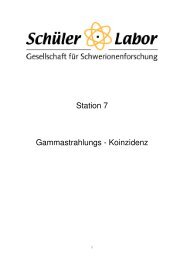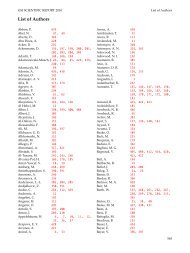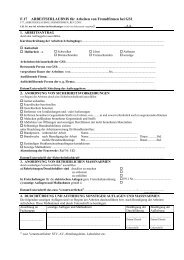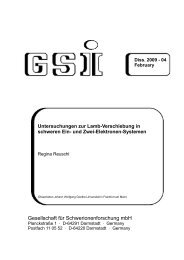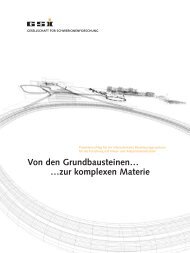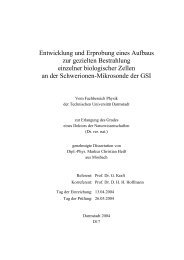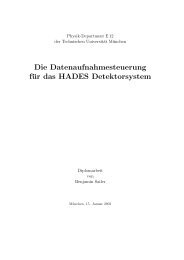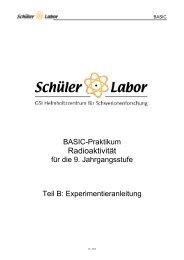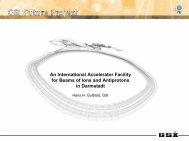CBM Progress Report 2006 - GSI
CBM Progress Report 2006 - GSI
CBM Progress Report 2006 - GSI
You also want an ePaper? Increase the reach of your titles
YUMPU automatically turns print PDFs into web optimized ePapers that Google loves.
<strong>CBM</strong> <strong>Progress</strong> <strong>Report</strong> <strong>2006</strong> Simulations<br />
Electron identification with RICH and TRD in <strong>CBM</strong><br />
C. Höhne 1 , S. Das 1 , S. Lebedev 2 , A. Ayriyan 2 , P. Stolpovsky 3 , G. Ososkov 2 , and V. Ivanov 2<br />
1 <strong>GSI</strong>, Darmstadt, Germany; 2 JINR-LIT, Dubna, Russia; 3 IHEP Protvino, Russia<br />
The observation of low-mass dilepton pairs and charmonium<br />
in the <strong>CBM</strong> experiment is one of the key measurements<br />
for the study of compressed baryonic matter in<br />
heavy ion collisions. The standard setup of <strong>CBM</strong> [1] foresees<br />
the measurement of electrons using particle identification<br />
with a ring imaging Cherenkov (RICH) detector and<br />
transition radiation detectors (TRD). In order to study the<br />
performance of the proposed setup with respect to electron<br />
identification and pion suppression capabilities, event reconstruction<br />
and particle identification routines have been<br />
developed. In this report first results on the performance<br />
of the <strong>CBM</strong> detector concerning electron identification including<br />
complete event reconstruction will be presented.<br />
The simulations were performed for central Au+Au collisions<br />
at 25 AGeV beam energy generated by UrQMD [2].<br />
These events were tracked through the <strong>CBM</strong> detector using<br />
GEANT, however, the transition radiation in the TRD<br />
was approximated by an external model still to be be improved.<br />
The event reconstruction starts with tracking in the<br />
STS, requiring a minimum of 4 STS hits. The tracks are<br />
then extrapolated to the RICH photodetector plane, to the<br />
TRD and with track following methods further on to TOF.<br />
Rings are found using ring reconstruction algorithms [3].<br />
Ring-track as well as TOF hit-track matching were applied<br />
choosing pairs having the closest distance. This way fully<br />
reconstructed events with information on RICH, TRD, and<br />
TOF signals for each track are available.<br />
For ring reconstruction in the RICH detector the most<br />
crucial parameter is the quantum efficiency of the photodetector,<br />
here existing MAPMTs from Hamamatsu were<br />
implemented (H8500-03) yielding about 21 hits per electron<br />
ring. Ring finding efficiencies are larger than 90% for<br />
midrapidity tracks and fall towards higher momenta [3].<br />
High momentum tracks are located in the central region<br />
of the RICH detector where also high ring densities exist.<br />
This leads to dropping ring finding efficiencies and increasing<br />
rates of fake rings. The most central part is therefore<br />
excluded reducing only slightly the geometrical acceptance<br />
for rapidities larger than 4. In order to further reject fake<br />
rings a set of ring quality cuts was developed reducing ring<br />
finding efficiencies by ∼5% [3]. A more severe reduction<br />
of the electron identification efficiency is the requirement<br />
of a maximum distance between ring and track. The cut is<br />
currently placed at 1 cm which has to be compared to a ring<br />
radius of 6.17±0.14 cm for electron rings. This selection<br />
rejects ≥5% of good matches (depending on momentum),<br />
however, is important to reduce wrong ring-track matches,<br />
e.g. of a primary vertex pion track and an electron ring from<br />
a secondary electron for which no track could be reconstructed.<br />
Indeed, these wrong matches are the major source<br />
13<br />
of electron misidentification for tracks with p < 8 GeV/c.<br />
Electrons are then selected choosing a range of radii of<br />
〈R〉 ± 3σ, with 〈R〉 = 6.17 cm and σ = 0.14 cm. Pions<br />
leak into this band and will be identified as electrons only<br />
from 8-10 GeV/c on. Figure 1 shows the resulting pion sup-<br />
pression defined as<br />
π identified as e<br />
π in RICH acceptance<br />
. Up to momenta<br />
of about 8 GeV/c the suppression factor lies between 500-<br />
1000 and pion misidentification is solely due to ring-track<br />
mismatches. From 8 GeV/c on pions leaking into the radius<br />
cut become dominant and lead to a continuous rise of<br />
the misidentification probability. Further sources of particle<br />
misidentification are mismatches of proton tracks to<br />
electron rings which can be fully eliminated using TOF information.<br />
pion suppression factor<br />
1<br />
-1<br />
10<br />
-2<br />
10<br />
-3<br />
10<br />
-4<br />
10<br />
-5<br />
10<br />
RICH<br />
RICH & TRD<br />
-6<br />
10 0 2 4 6 8 10<br />
p [GeV/c]<br />
Figure 1: Pion suppression for electrons identified in RICH<br />
and in RICH & TRD for central Au+Au collisions at 25<br />
AGeV.<br />
Pions can be further rejected using energy loss information<br />
from the TRD. As first step a cut of 70 keV is placed<br />
on the summed energy loss in the 12 TRD layers rejecting<br />
already 90% of the remaining pions. For the final pion<br />
rejection shown in figure 1 electron/pion separation is improved<br />
using a statistical analysis of the energy loss spectra<br />
in each layer [4]. The combined pion suppression in RICH<br />
and TRD reaches values larger than 10 4 for p > 1 GeV/c.<br />
In future, these simulations will be improved taking into<br />
account the detector responses in more detail.<br />
References<br />
[1] V. Friese et al., The <strong>CBM</strong> experiment at FAIR, this report.<br />
[2] S.A. Bass et al., Prog. Part. Nucl. Phys. 41 (1998) 255.<br />
[3] S. Lebedev at al., Ring recognition in the RICH detector of<br />
<strong>CBM</strong>, this report.<br />
[4] P.V. Zrelov, V. Ivanov, NIM A 310 (1991) 623.<br />
E.P. Akishina et al., Application of the ω k n test for J/ψ detection<br />
in the <strong>CBM</strong> experiment, this report.



